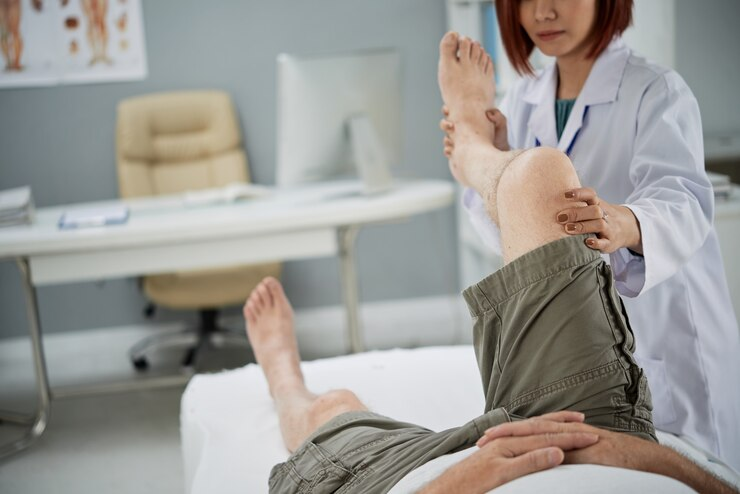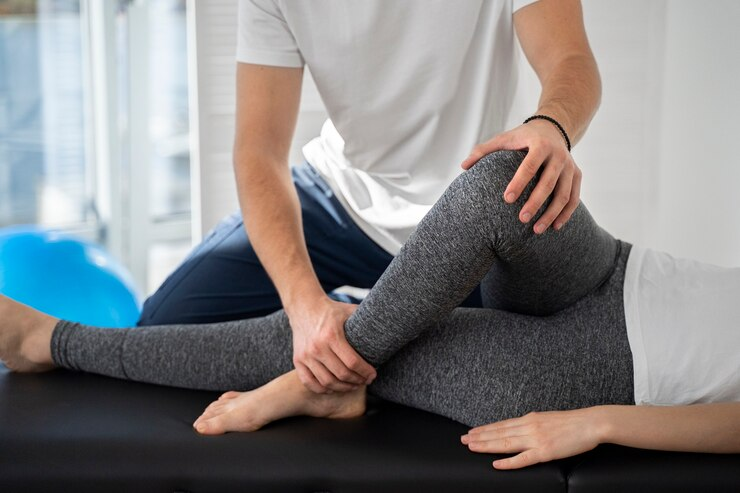Hip Fracture Treatment in Singapore

Hip fractures are a serious health concern, especially for older adults, often leading to pain, immobility, and reduced quality of life. Hence, early diagnosis and effective hip fracture treatment from a specialist are crucial for ensuring optimal broken hip recovery and restoring mobility.
What is a Hip Fracture?
A hip fracture is a break in the upper part of the femur (thigh bone) close to the hip joint. There are different types of hip fractures:
- Femoral neck fracture: Occurs just below the ball of the hip joint.
- Intertrochanteric fracture: Occurs between the neck and the shaft of the femur.
If you suspect you have a hip fracture, you may also experience:
- Severe pain in the hip or groin.
- Inability to walk or bear weight.
- Swelling, bruising, and visible deformity in severe cases.
Causes and Risk Factors for Hip Fractures
Hip fractures can occur from:
- Falls on the same level, especially in elderly individuals.
- High-impact trauma, such as car accidents, in younger individuals.
There are also additional factors that increase one’s risk of suffering from a hip fracture:
- Osteoporosis and weak bones.
- Age-related bone density loss.
- Chronic medical conditions affecting mobility or balance.
- Lifestyle factors such as smoking, poor diet, and lack of exercise.
When to See a Hip Fracture Specialist
If you experience any of the following, it’s advisable to consult a fracture specialist:
- Sudden and severe hip pain after a fall or trauma.
- Inability to stand or move the affected leg.
- Swelling and discolouration around the hip.
- Shortening or outward rotation of the injured leg.

Diagnosis of Hip Fractures
Specialists usually order a series of comprehensive assessments to determine the type and extent of the injury. Here’s what diagnosis usually entails:
- Physical Examination: To assess mobility, pain, and deformity.
- X-rays: To confirm the type and extent of the hip fracture.
- MRI or CT Scans: For more complex cases to detect soft tissue damage or subtle fractures.
Non-Surgical Treatment for Hip Fractures
Non-surgical management may be possible in specific cases, such as:
- Stable fractures in medically unfit patients.
- With use of pain relief medications, physical therapy, and mobility aids.
However, it is well-known medically that non-surgical options have limitations for the majority of hip fracture cases, as they may not provide adequate stability for healing or restore optimal function.
Surgical Options for Hip Fractures
Several surgical options are available for treating hip fractures. Our specialist will assess your specific type of fracture and may recommend the following:
- Internal fixation (using screws and plates): For stabilising the fracture.
- Hemiarthroplasty: Partial hip replacement for severe femoral neck fractures.
- Total Hip Replacement (THR): For fractures involving arthritis or severe joint damage.
These surgeries usually present significant benefits of:
- Almost immediate reduction in pain.
- Faster recovery and mobility restoration, where physiotherapy and walking the next day after operation is possible.
- Reduced risk of complications like blood clots in the legs, pneumonia, urinary tract infections, and overall declining health.
Recovery After Hip Fracture Surgery
This is a crucial step towards regaining mobility and independence after sustaining a broken hip. While the recovery process depends on individual healing, severity of the fracture, and the type of surgical procedure done, here is the typical timeline:
- Walking with assistance: 1–2 weeks.
- Resumption of daily activities: 6–8 weeks.
- Full recovery: Up to 6 months.
While every recovery process is different, here is what you can typically expect post-surgery:
- Post-surgical pain management and wound care.
- Use of walking aids like crutches or walkers.
- Physical therapy to rebuild strength and mobility.
- Follow-up appointments for monitoring progress.

Cost of Hip Fracture Surgery in Singapore
The costs of broken hip surgery vary significantly depending on various factors. It’s essential to consult with a specialist to get a personalised quote based on your specific condition and treatment plan. Singapore Ministry of Health publishes average hospital bill sizes on its website. In general, the costs can be affected by:
- Type of surgery performed.
- Complexity of the fracture.
- Length of hospital stay.
- Extent of post-operative care.
Choosing the Right Hip Fracture Specialist in Singapore
A specialist can diagnose your condition, recommend the most appropriate management plan, and perform the required surgery. Here’s what to look for:
- Experience in treating various types of hip fractures.
- Expertise in surgical techniques, including minimally invasive options.
- Access to comprehensive pre- and post-operative care.
If you’re looking for a trusted orthopaedic clinic, consider Centurion Orthopaedic Centre. We have a team of dedicated and experienced bone fracture specialists who are committed to providing comprehensive and personalised care with the sole aim of getting you back on your feet. We also offer a wide range of treatment options, from conservative management to specialised surgical techniques, using industry-leading facilities and technology.
Frequently Asked Questions About Hip Fracture Treatment
What is the recovery time for a hip fracture?
Recovery from a broken hip varies depending on the severity of the fracture, the individual’s overall health, and the type of surgery performed. Generally, it takes several weeks to a few months to regain mobility and independence. Our hip fracture specialist can provide a more accurate timeline.
How can I prevent hip fractures in older adults?
Preventing hip fractures in older adults involves a multi-faceted approach. This includes maintaining strong bones through calcium and vitamin D intake, regular exercise, and fall prevention. Addressing risk factors like osteoporosis and improving balance could also reduce the risk of falls and fractures.
Is hip fracture surgery painful?
While some pain is expected after hip fracture surgery, it is typically well-managed with medication. The surgical technique and individual pain tolerance also play a role. In fact, most individuals find that the hip fracture pain is almost immediately much better after surgery.
How long does hip fracture surgery take?
The duration of hip fracture surgery depends on the complexity of the fracture and the surgical approach. Generally, it takes one to three hours to complete.
Is hip fracture surgery Medisave or insurance claimable?
Yes, hip fracture surgery is typically Medisave and insurance claimable. However, your coverage amount will vary depending on your policy details. It is best to check with your insurer and our clinic to confirm the claimable amounts and any out-of-pocket expenses.

Services
Medisave / Insurances
Treatments
Ankle Sprain & Treatment
Cartilage Repair Treatment
Bone Fracture Treatment
Alternatives to Knee Replacement
Knee Replacement Surgery
ACL Reconstruction Surgery
Knee Cartilage/Meniscus Tear Injury
Heel Spur Treatment
Hip Replacement Surgery
Hip Scope Surgery
Shoulder Scope Surgery
Ankle Ligament Surgery
Spinal Injection Therapy
Steroid Injection
Patient Resources


